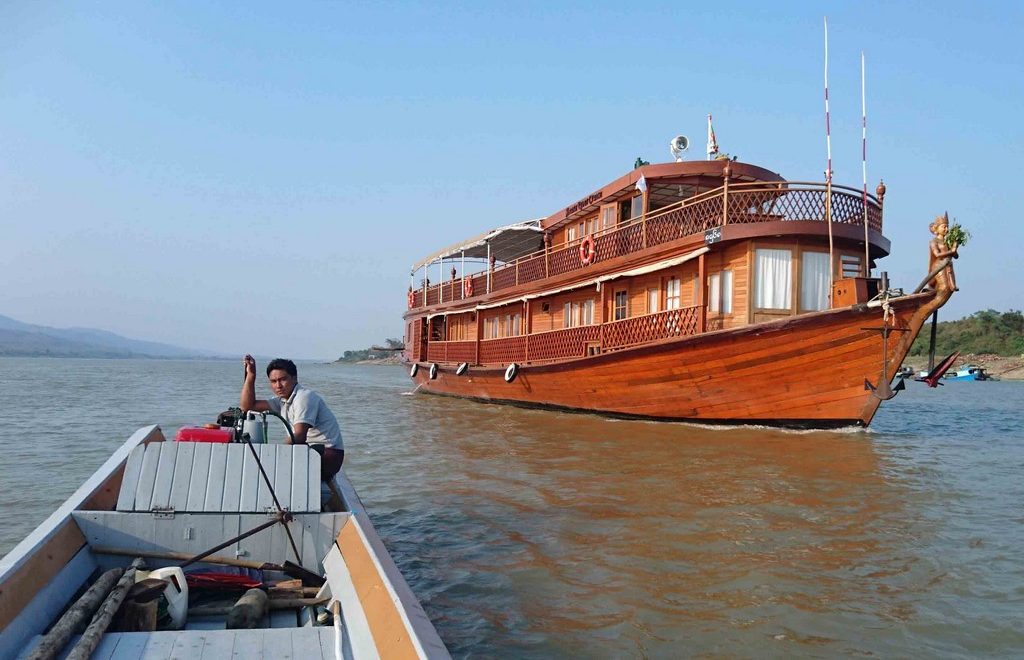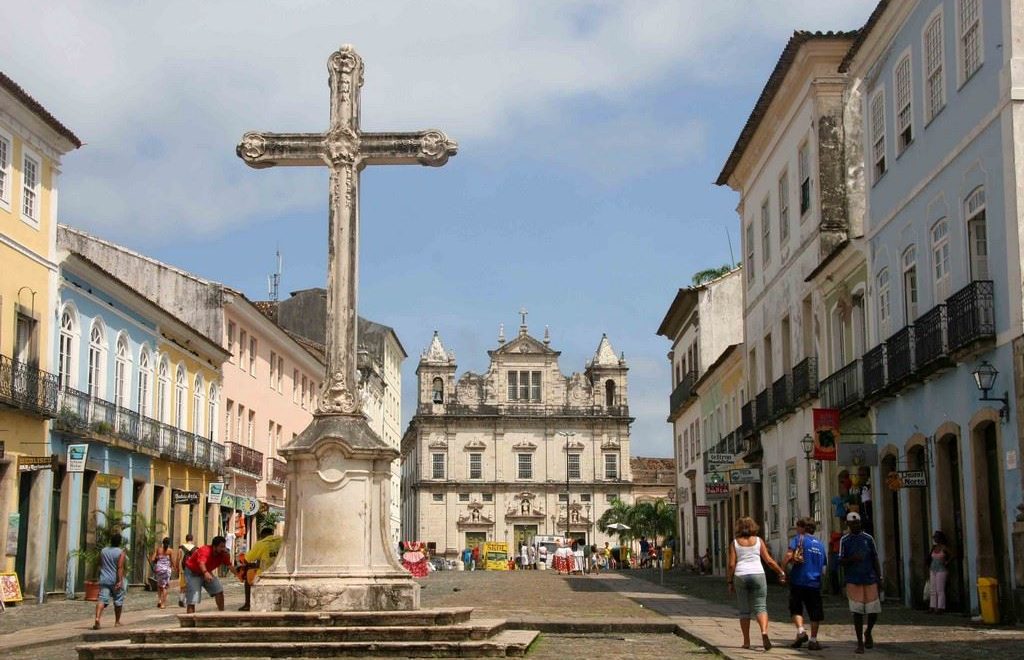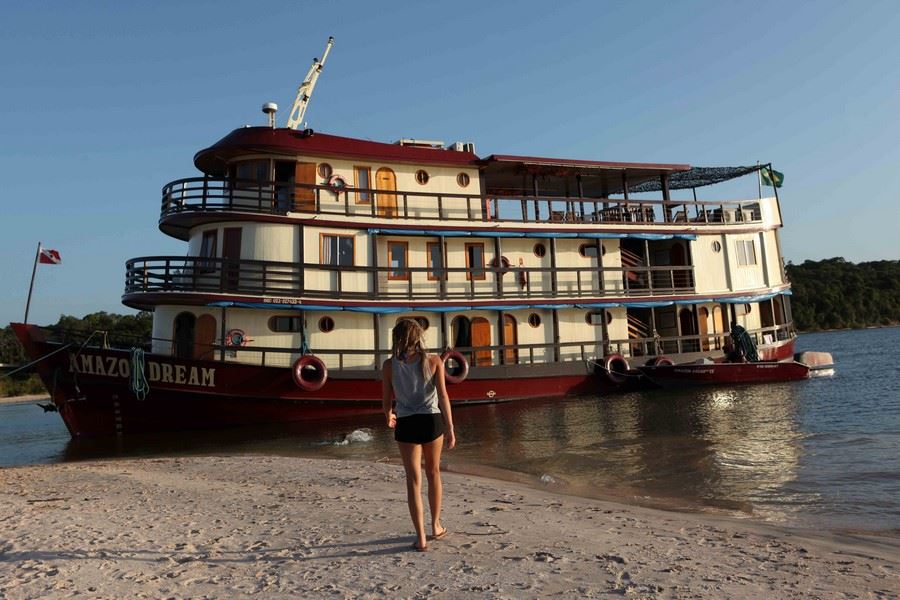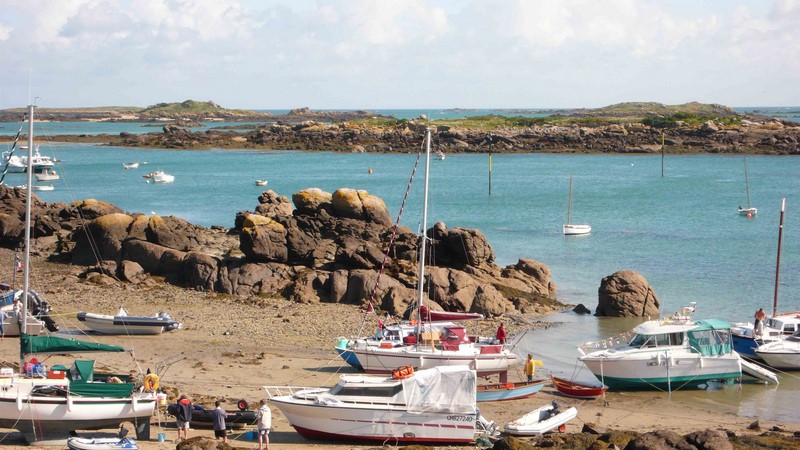
52 islets at high tide, 365 at low tide, not counting the reefs. This is Chausey, Europe?s largest archipelago, with its rocky outcrops scattered across an area of 5,000 hectares at ebb tide. Take a stroll through incomparable landscapes, the charm of which lies in the movement of the land due to the highest tides in Europe.
"Our problem in Granville is Chausey...", often jokes the sailors who venture to this string of fantastic islands, an hour from Granville. That's the magic of Chausey: a constellation of islets whose shape changes constantly with the ebb and flow of the tide, and whose shallows - the grunes (pronounced greunes) - have taunted many a keel. Lunar at low tide, Venetian at mid-tide and finally maritime at flood tide, Chausey reveals a different silhouette and colours every hour of the day. Subject to the powerful tides that undress it, the Norman beauty is indomitable. Even the English have given up trying to take her from us. This marine labyrinth is first and foremost a paradise for sailors, and every boat can find an anchorage without giving the impression that the place is overrun ... at least for the time being! A natural reserve and heritage site in Lower Normandy, Chausey is a little jewel that can also be savoured by strolling along the damp paths of its undulating bocage or its fragmented foreshore. Tabarly loved these islands so much that he considered them to be one of the most beautiful archipelagos in the world! A stele is dedicated to him at the top of the street leading to the Grande Cale.
Coastal tour
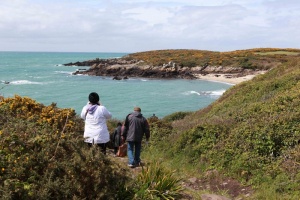 Battered by spring gusts and shrouded in mist, Chausey emerges from its winter torpor with the arrival of the first tourists and walkers. Right from the slipway, the presence of numerous lobster traps is a reminder of the island?s speciality. Like its Anglo-Norman neighbours on the Minquiers plateau, Chausey and its pebble fields are a favourite haunt for this tasty crustacean. The fishermen of Chausey are gradually disappearing - there is only one fisherman left today - but more and more enthusiasts are trying their hand at sea bass or the famous "bouquet" with "bichettes". This is fishing to be enjoyed in the evening at anchor, in this dream setting, or at the Hôtel du Fort et des Îles.
Battered by spring gusts and shrouded in mist, Chausey emerges from its winter torpor with the arrival of the first tourists and walkers. Right from the slipway, the presence of numerous lobster traps is a reminder of the island?s speciality. Like its Anglo-Norman neighbours on the Minquiers plateau, Chausey and its pebble fields are a favourite haunt for this tasty crustacean. The fishermen of Chausey are gradually disappearing - there is only one fisherman left today - but more and more enthusiasts are trying their hand at sea bass or the famous "bouquet" with "bichettes". This is fishing to be enjoyed in the evening at anchor, in this dream setting, or at the Hôtel du Fort et des Îles.
For those who are not so keen on sailing, the Grande Ile (as it is known, even though it is only 2km long and between 200 and 700m wide) offers a coastal path to discover the wild beaches that dot its shores. If you walk non-stop, it will take you three or four hours to complete the circuit. There are no roads here. Cars and bicycles too. The only things on the road are the tractor that collects the rubbish, the hotel's electric buggy and the islanders' carts.
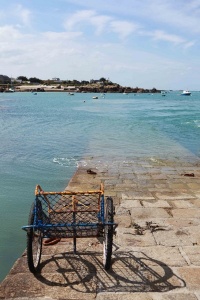 With the waves lapping and a light Norse wind, we set off to explore the island from the south and east, taking the seaside path that begins below the hotel. We pass two granite landmarks, the Baudry and Lambert towers, strange beacons erected in the mid-19th century to put an end to the quarrels between fishermen from Granville and Cancalais.
With the waves lapping and a light Norse wind, we set off to explore the island from the south and east, taking the seaside path that begins below the hotel. We pass two granite landmarks, the Baudry and Lambert towers, strange beacons erected in the mid-19th century to put an end to the quarrels between fishermen from Granville and Cancalais.
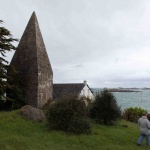 The alignment of these two landmarks separated the Bay of Mont-Saint-Michel in two. On fishing days, an official boat would anchor on this demarcation line and ensure that the zones were respected. The towers bear the names of the two sworn guards who were part of the maritime commission responsible for defining this delicate alignment? and putting an end to brawls between sailors.
The alignment of these two landmarks separated the Bay of Mont-Saint-Michel in two. On fishing days, an official boat would anchor on this demarcation line and ensure that the zones were respected. The towers bear the names of the two sworn guards who were part of the maritime commission responsible for defining this delicate alignment? and putting an end to brawls between sailors.
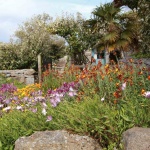 The path winds past a number of flower-filled houses, mostly occupied during the holidays and rented out on long leases, before leading to the island?s lighthouse. It was first lit in October 1847. From its height of 39 metres, it still emits a white light every five seconds, visible from 22 miles away.
The path winds past a number of flower-filled houses, mostly occupied during the holidays and rented out on long leases, before leading to the island?s lighthouse. It was first lit in October 1847. From its height of 39 metres, it still emits a white light every five seconds, visible from 22 miles away.
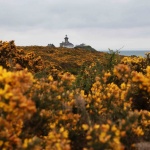
Next to it, the fort received its foundation stone in 1859 under the reign of Emperor Napoleon III. It was completed in 1866. But the funny thing is that it was never used because the wars against England were well and truly over. Decommissioned forty years after its opening, the fort housed 300 German and Austrian prisoners during the First World War? and a small garrison of the Third Reich during the Second. Today, it is home to fishing families who live year-round in the former vaulted casemates, which are covered in grass. Protected by a deep moat that forms a pentagonal shape, the building is well worth a visit.
We then make a short stop at Port Marie. Curiously, the word "port" is used here to designate certain beaches. In fact, it was originally used to refer to the precarious shelter formed by the coves that cut into the island.
Nature reserve
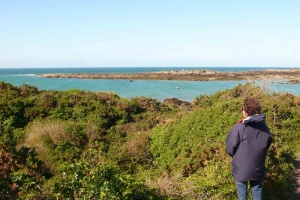 Before reaching Port Homard and its superb beach, which is very popular during the summer months, you will pass around the Pointe de Bretagne, an arid and windy moorland where the granite competes with impenetrable bushes of broom and gorse tangled with brambles. Typically Armorican, this moorland covers almost a third of the island?s surface area. It is this heath that gives the Chausey landscape its splendour, both in terms of the golden colour of its blooms and the delicate fragrance that perfumes the paths in fine weather.
Before reaching Port Homard and its superb beach, which is very popular during the summer months, you will pass around the Pointe de Bretagne, an arid and windy moorland where the granite competes with impenetrable bushes of broom and gorse tangled with brambles. Typically Armorican, this moorland covers almost a third of the island?s surface area. It is this heath that gives the Chausey landscape its splendour, both in terms of the golden colour of its blooms and the delicate fragrance that perfumes the paths in fine weather.
Lizards and rabbits abound. Here, however, the word is avoided and they are referred to as long-eared, poodles or cannibals, so taboo is the word for any self-respecting sailor.
Many nesting seabirds take refuge on the island and islets: great cormorants, crested cormorants, sea gulls, terns, etc., as well as a number of migratory and wintering birds: geese, plovers, gannets, etc. And the rare shelduck, which nests in the burrows, has made it its favourite haven. And the rare shelduck, which nests in burrows, has made it its favourite haven. It is best spotted out of season, when the flood of visitors has subsided. The entire archipelago is classified as an ornithological reserve, and hunting is of course prohibited.
Port Homard beach and Château Renault
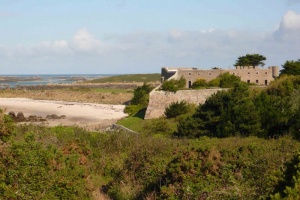 Continuing along the path that runs alongside the granite boulders, you come to the beach at Port Homard, dominated by the Château Renault. Built in 1559 under the reign of Henry II, this austere building, also known as "the old fort", has suffered many setbacks over the centuries, particularly as a result of the destruction wrought by English troops. The car manufacturer Louis Renault, who fell in love with Chausey, found it derelict when he bought it in 1922 and had it completely restored before adding the curious swimming pool carved out of the granite at its feet (now disused) and the boathouse, now in ruins, under the semaphore. The Château, which now belongs to one of the three families in the Société Civile Immobilière (SCI) that owns almost the entire island and its islets, is not open to visitors.
Continuing along the path that runs alongside the granite boulders, you come to the beach at Port Homard, dominated by the Château Renault. Built in 1559 under the reign of Henry II, this austere building, also known as "the old fort", has suffered many setbacks over the centuries, particularly as a result of the destruction wrought by English troops. The car manufacturer Louis Renault, who fell in love with Chausey, found it derelict when he bought it in 1922 and had it completely restored before adding the curious swimming pool carved out of the granite at its feet (now disused) and the boathouse, now in ruins, under the semaphore. The Château, which now belongs to one of the three families in the Société Civile Immobilière (SCI) that owns almost the entire island and its islets, is not open to visitors.
To protect the dunes and prevent them from being trampled, the company has installed fences and planted thousands of oyats to allow the plant cover to recover and halt the erosion process. 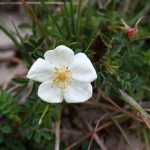 Beach walkways now channel visitors, allowing the blue thistle, the superb little "pimprenelle" rose and other rare and protected species (picking is prohibited), such as the blood geranium and the French helleborine, to grow again. As for the heart of the island, the paths are well-marked and the gorse aggressive enough to discourage wild escapes.
Beach walkways now channel visitors, allowing the blue thistle, the superb little "pimprenelle" rose and other rare and protected species (picking is prohibited), such as the blood geranium and the French helleborine, to grow again. As for the heart of the island, the paths are well-marked and the gorse aggressive enough to discourage wild escapes.
His majesty the elephant
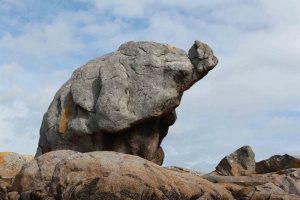 After the Rochers des Moines, Grande-Grève beach slopes down towards the open sea in a narrow curve of white sand. We continue our tour as far as the famous elephant, one of the island?s many stone statues. We approach it at low tide, crossing a chaos of granite blocks darkened by seaweed. It looks just like him!
After the Rochers des Moines, Grande-Grève beach slopes down towards the open sea in a narrow curve of white sand. We continue our tour as far as the famous elephant, one of the island?s many stone statues. We approach it at low tide, crossing a chaos of granite blocks darkened by seaweed. It looks just like him!
Further north, the ancient semaphore, perched on the hill at the island's highest point, keeps watch over the lonely rocks. On a clear day, you can see Jersey, Granville, Mont-Saint-Michel and even Saint-Malo. Built in the mid-19th century, it was Chausey's communications hub, receiving messages from the mainland. Today, it houses a scientific relay station.
In this wild part of Grande-Ile, there are many old granite quarries, huge worksites on the water?s edge that have been exploited for nine centuries. At one time, there were as many as 600 quarrymen on the island. The ramparts and church of Granville, Mont-Saint-Michel and even the quays of London and Dieppe and the pavements of Paris were built using the granite that forms the island's foundation.
A miniature bocage
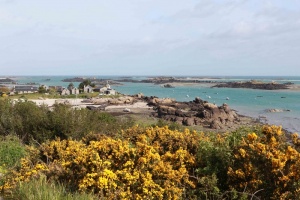 Returning via the heart of the island, you might think you were walking through the heart of the Normandy bocage. On the fields of the old farm (the last farmers left in 1991), Ouessant sheep, recently introduced by a group of breeders, graze peacefully. The farmhouse has been renovated and converted into gîtes.
Returning via the heart of the island, you might think you were walking through the heart of the Normandy bocage. On the fields of the old farm (the last farmers left in 1991), Ouessant sheep, recently introduced by a group of breeders, graze peacefully. The farmhouse has been renovated and converted into gîtes.
Just opposite, the tiny houses of the village of Blainvillais spread out their flowerbeds. Built around 1825, these old thatched cottages were originally home to barrow-men and quarrymen from Blainville (a small town on the west coast of the Cotentin peninsula). Most of them, who became fishermen when the quarries closed, came in the summer to hunt down bouquets and shellfish, occupying these small, low houses whose renovation was financed by Louis Renault between the wars.
 Just like the bell tower of the little chapel overlooking the slipway, which is well worth a visit. Magnificently lit by the beautiful stained glass windows by Yves de Saint Front, son of the famous Chausian painter Marin-Marie, it contains the statues of Sainte Anne and Saint Benoist and two models of boats, including a beautiful three-masted ship offered as an ex-voto.
Just like the bell tower of the little chapel overlooking the slipway, which is well worth a visit. Magnificently lit by the beautiful stained glass windows by Yves de Saint Front, son of the famous Chausian painter Marin-Marie, it contains the statues of Sainte Anne and Saint Benoist and two models of boats, including a beautiful three-masted ship offered as an ex-voto.
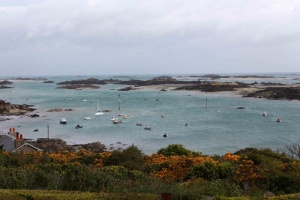 Finally, our walk ends in the small garden of the Hôtel du Fort et des Iles, overlooking the Sound, the channel that runs alongside the Grande Île. Here, with a glass of white wine in hand, we enjoy watching the sun decline over the archipelago. The channels slowly disappear with the ebb, creating a fleeting, shifting polychromy. Chausey isn't something you get to grips with straight away. It's Chausey that grabs you? patiently. As the saying goes: "Who goes to Chausey once, comes back a hundred times".
Finally, our walk ends in the small garden of the Hôtel du Fort et des Iles, overlooking the Sound, the channel that runs alongside the Grande Île. Here, with a glass of white wine in hand, we enjoy watching the sun decline over the archipelago. The channels slowly disappear with the ebb, creating a fleeting, shifting polychromy. Chausey isn't something you get to grips with straight away. It's Chausey that grabs you? patiently. As the saying goes: "Who goes to Chausey once, comes back a hundred times".
Text and photos: Brigitte Postel
Tides
It's impossible to ignore this, even when the tidal range is low. While the maximum tidal range is around 15 metres, it is already 5 metres for an average neap tide, and more than 10 metres for an ordinary 90° tide. High tides are 5 minutes later and low tides 15 minutes later than in Saint-Malo, the reference port.
Caution
Much of the archipelago can be explored on foot at low tide on high tide days. The tongues of sand offer a wider area to explore at ebb tide, but you need to calculate carefully as the tide comes back in very quickly and channels can fill up, cutting off the return journey for the intrepid. The excursion therefore calls for a great deal of caution if you don?t want to find yourself stranded on an islet waiting for the next tide. Beware also of the mudflats. Landing on the islets (bird sanctuaries) is forbidden during the nesting season.
Weather
Whatever the weather, this archipelago retains all its charm. The weather is influenced by the tides and can change very quickly.
Accommodation
Hôtel du Fort et des Iles
This is the only hotel on the island. It has 8 rooms, which means you need to book well in advance. Even if you don't fancy a meal, the large bar room is well worth a visit, and offers superb views over the Sound.
www.hotel-chausey.com
Tel. 02.33.50.25.02
Open from mid-April to the end of September
Restaurant on site.
Flats in the old farmhouse
http://ileschausey.com/textes/viepratique/accueil-laferme.htm
Tel. 02.33.90.90.53
20 flats for 2/3 to 8/9 people.
Communal gîtes in the former presbytery and school building
www.ville-granville.fr/office_municipal_tourisme_granville.asp
Tel. 02.33.91.30.03 (Office du Tourisme) - French only
5 gîtes for 4 to 7 people.
Daily rentals available from October to the end of March. Weekly rentals only from early April to late September.
Getting there
Compagnie Jolie France
http://vedettejoliefrance.com - Tel. 02.33.50.31.81
Service all year round. Every day from April to September. October to March: Wednesdays, Saturdays, Sundays and high tide days,
Crossing time: 30 to 55 minutes depending on the boat,
Compagnie des Iles Chausey
Daily service from April to September. Tel. 02 33 50 16 36.
Practical information, the Chausiais website : http://ileschausey.com



